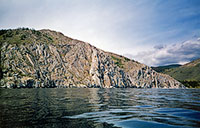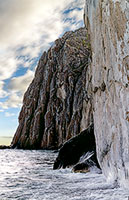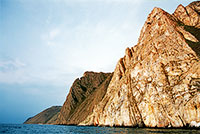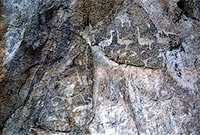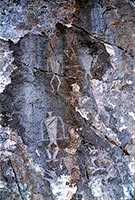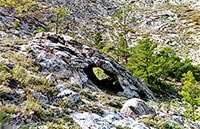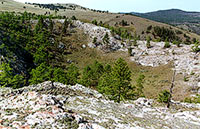SaganāZaba Cliff
The cliff of SaganāZaba is one of the most beautiful places on the west coast of Lake Baikal. Situated 5 kilometres to the northāeast of Cape Krestovskii in Pribaikalskiy National Park. Anyone who has travelled by kayak along the western coast of Baikal, remembers the moment when the SaganāZaba cliff came into sight from behind the promontory KhoboyāKhushun, 2ā3 kilometres to the northāeast, without fail. From a distance SaganāZaba looks majestically gloomyĀ ā a comb of massive legābuttresses disappearing steeply into the water.
Near by, when the cliff is alongside, the initial hint of gloominess disappears because of the roseāwhite shade of crystalline limestone of which the rock is formed. SaganāZaba is noticeably different from the surrounding cliffs because of its unusual light colouring, that changes depending on the time of day, and the uncommonly smooth forms of its rock. In summer the cliff is particularly beautiful in the rays of the rising sun. As if on purpose, Nature has placed the Chyorny (black) cliff beside it, to underline the exclusiveness of its child.
On the stretch of Baikal's coastline from Olkhonskiye Vorota to Cape Krestovskii there are a number of white marble cliffs similar to SaganāZaba; but it was SaganāZaba that was given the status of Natural monument. Prehistoric rock paintingsĀ ā petroglyphs on one of its facesĀ ā brought worldāwide fame to the cliff. The drawings were executed in different epochs, going back to the bronze and late iron ages (two thousand years B.C.Ā ā one thousand years A.D.), that is, the oldest painting is some 4000 years old. The petroglyphs of SaganāZaba became known to science in 1881, thanks to the work of Nikolai Agapitov. Subsequently, they have been studied by many archaeological expeditions, some international. The rock paintings of SaganāZaba form a composition of figures of humans, and animals.
There were some 60 paintings at the moment of discovery. Today, some of these have been lost for different reasons. Some, at the base of the composition, have been erased by waves, others have been destroyed by people. The monks of Posolskii monastery, apparently by way of an ideological war with shamanism, cut out crosses over the prehistoric petroglyphs. Today's vandals have also done their bit, pouring out their feeble minds on the sacred rocks of our ancestors.
The oldest paintings on the rock of SaganāZaba was executed in the manner of pointācuts, while the later onesĀ ā by line cuts. A characteristic detail of the drawing of humans on the rock is small horns on the head. This could mean that it is not humans that are represented here, but spirits or shamans. Amongst the paintings are images of deer, bulls, dogs, geese and swans.
The rock paintings are the most famous, but not the only archaeological finds of SaganāZaba. Not far from the cliff many traces of prehistoric human presence have been discovered. In the eastern part of bay BurunāSaganāZaba, adjacent to the cliff on its eastern side, excavations brought to light a prehistoric camp of the Neolithic and late iron ages (five thousand years B.C.Ā ā one thousand years A.D.), the remains of pottery, scrapers, knives and an axe have been found. Not far away, a place of religious ritual of the 17th to 19th centuries consisting of a number of sacrificial hearths was found. The site, most likely, was used for rituals of homage to the lord of the cliff of SaganāZaba.
From the depression BurunāSaganāZaba one can climb in 15ā20 minutes to the top of the cliff from where there is a magnificent view of Baikal. The top of the cliff itself, scattered with a few larch trees, is quite unusual because of a deep (15ā20 metres) crater 40ā50 metres in diameter. The peculiar slopes of the rock show interesting forms of wind erosion. Limestone is not a durable material, easily being worn away by rain, sun and fierce Baikal winds, even icicles drip out nests in it without much trouble. Thanks to this feature of crystalline limestone, one can find curious formations on the slopes of the cliff.
There was once a cave at the top of SaganāZaba cliff about which there is contradictory information. According to one source, the entrance to the cave was lost long ago, possibly it was destroyed by local inhabitants, or collapsed as the result of an earthquake. Other sources relate that the cave was well known until not long ago and even archaeological finds were made in it. The cave is linked to a legend, according to which there is gold, that Chinese boatmen were unable to ferry over Baikal, hidden in its depths.
Ā© Magic Baikal
Related links:

